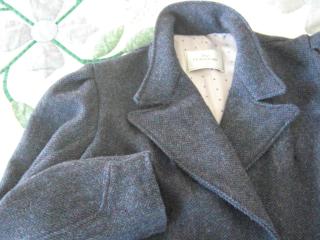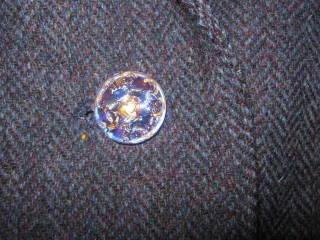This project started when in a fit of madness I bought a French sewing pattern allegedly dating to the 1940s.


Those of you not interested in sewing, look away now.
If this coat were being sold in a shop window it would be labelled: Made in Scotland of pure Hebridean wool. Macclesfield silk lining; Czech glass buttons. Patron-Modèle pattern designed and cut in Paris, circa 1940. (And I would have to charge something like at least £800 for it, although it didn’t cost me anywhere near that much except in time and energy. There is nothing like making your own clothes to make you appreciate why good-quality stuff is so expensive.)

I haven’t been able to date the pattern accurately. It closely resembles other Patron-Modèle patterns dating to the mid-thirties, except that the picture on mine is a little more modern looking, and the price has gone up from 3 to 5 francs. However, on a similar postwar pattern purportedly dating to 1948, the price has suddenly soared to 55 francs. The giant inflation suggests a radical change in the market, or, well, A WAR, between the two patterns being issued. I haven’t got the strength of character required to do the detective work on French economics that would help me figure out this mystery, but I’m guessing
my pattern dates to somewhere between 1937 and 1947. I think it’s probably
just pre-war but I could be wrong.
Anyway it’s in French, so my first project was to sit there with my mother’s college French dictionary (handily dating to 1950) and translate the darn thing. Boy did I learn a lot of new words (facing, interfacing, lapel, pleat, etc.). I had the cloth to hand already, which I’d ordered for a different project but which had turned out to be heavier than I’d expected. I’d bought the lining from the Macclesfield Silk Museum at Paradise Mill many years ago and never did anything with it. The pattern made no contingency for lining, so I kind of made it up as I went along, using my old dress coat as a guide. Incidentally, I bought my old dress coat at Wanamaker’s in about 1987, and it is AMAZING how similar in style it is to this one.
Ladies’ coats are rather timeless, I have concluded.


When I’d finished laying out the pattern and followed the directions for increasing the size I was feeling extremely pleased with myself, and it wasn’t till I cut out the LAST PIECE - the pockets - that I realized there was no seam allowance included on ANYTHING.

And this is actually another thing that dates the pattern, because my 1948 pattern explicitly states to allow 3 cm around the pattern edges for a seam allowance.
I had to put it all aside for a few days while I considered this problem. (If you don’t sew and you haven’t fallen asleep, it means that once you’ve stitched everything together it will be SMALLER. My hands weren’t going to fit in the pockets.)
I ended up sewing the whole thing with 1/4 inch (0.5 cm) seams (which is extremely narrow), reinforced with zigzag stitching, and the zigzags reinforced with another seam - essentially I’ve sewn the entire coat together THREE TIMES. It is a little tight, but not impossibly so, or uncomfortable. If I hadn’t increased to the next size up before I cut the fabric, it would have been a disaster. I’m just so relieved that I can actually get the darn thing on.
Apart from that, the sewing wasn’t difficult. The instructions, once translated, are quite straightforward, and recognizable to anyone who’s done any modern dressmaking. They’re pretty terse, though - they fit on the outside of the pattern envelope, and no detailing is included - you’re expected to know how to do things like set in sleeves, pockets, buttonholes, etc. (They’re not even
mentioned.)




I bought the pattern on eBay from
ryphat, whose shop, Au Fil du Temps, specializes in antique French patterns (and other antique French stuff. Now you too, like Sara Crewe, can wear real Valenciennes lace). It seems a bit sinful to USE the pattern, and stick little tears and pinholes in it. But what a great way to acquire a vintage wardrobe!
Haberdasher’s secret tip: Decent PINS are a fantastic investment.
















